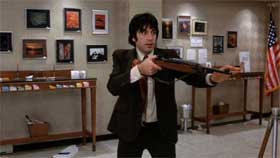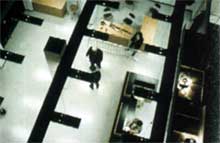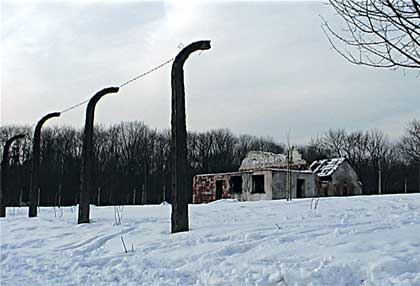 History will repeat itself (part 1)
History will repeat itself (part 1)
Second episode of my notes about the exhibition History will repeat itself. Strategies of Reenactment in Contemporary (Media) Art and Performance at Hartware MedienKunstVerein, in Dortmund (Germany.)
One of the most striking piece in the exhibition is Pierre Huyghe’s installation The Third Memory, 1999, but then each time i see one of Huyghe’s work i claim that “This is one of my favourite art pieces ever!” So i might be a bit biased.
The movie revolves around a bank robbery committed by John Wojtowicz in Brooklyn on August 22, 1972. Woytowicz needed the money to finance the sex change operation of his boyfriend (Ernest Aron who later became Elizabeth Eden), things turned nasty, hostages were taken and Wojtowicz and his accomplices were arrested. The bank robbery was one of the first to be broadcast live on television, and followed by millions of people. However, the $7,500 he made selling the movie rights to the story to Sidney Lumet helped finance Aron’s sex reassignment surgery. The film, Dog Day Afternoon, was released in 1975 and starred Al Pacino. That same year, Wojtowicz wrote a letter to the New York Times out of concern that people would believe the movie version of the events which he said was only 30% accurate.
Huyghe, re-built the movie set of the bank and asked Wojtowicz to retell the story.
Using a two-channel video projection which shows a duplication of Pacino-as-Wojtowicz, an old tv interview of the boy/girlfriend, and posters, Huyghe builds from a “first memory� of the original crime to a “second memory� with the film’s recreation of that crime, to arrive at a “third memory,� a blurring of the documented and the imagined.
What makes it even more complex is that Wojtowicz had apparently used one of Pacino’s lines from The Godfather to actually rob the bank. So a fiction influenced him and then the robbery was televised and became a storyboard for another fiction, Dog Day Afternoon. Now whose reality can you trust? Wojtowicz’ who plays some kind of Al Pacino over 25 years after the event took place? Huyghe’s? But who knows what he has edited out or manipulated?

Also by Huyghe: Celebration Park.
Another work that closely intertwins historical facts and their Hollywood representation is the two-channel work Spielberg’s List, by Omer Fast. Ten years after Steven Spielberg’s film Schindler’s List, Fast travelled to Krakow, where the film was made and interviewed inhabitants who worked as extras in the concentration camp scenes of the Hollywood film.

From the discussions about the director’s selection of the extras, the scenes of death and humiliation that they enacted and their feelings about the experience emerge confusions between the film and the 1940s events, especially when it emerges that some of the extras were camp survivors.
The audience is further disoriented by the parallel projections, they do not always make it possible to recognize which images come from Fast’s own material and which ones were taken from Spielberg’s, the camp built for the movie being a bigger tourist attraction than the real one in the area, because it is in better shape (the film gave a huge boost to the local Holocaust Movie Tourism.) Aided by subtly manipulated subtitles, memories of the media-event mingle with the real historical ones.
 Omer Fast’s Spielberg’s List is not intended as a critique of Hollywood. By neutralising the differences between the true story and the later reinterpretation of the events, Fast wants to demonstrate how strongly media images shape and overlie our memories, and that films have assumed the function of monuments for collective memory.
Omer Fast’s Spielberg’s List is not intended as a critique of Hollywood. By neutralising the differences between the true story and the later reinterpretation of the events, Fast wants to demonstrate how strongly media images shape and overlie our memories, and that films have assumed the function of monuments for collective memory.
